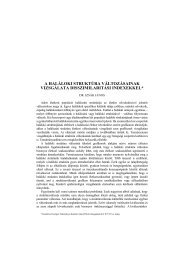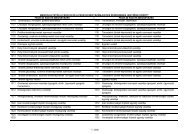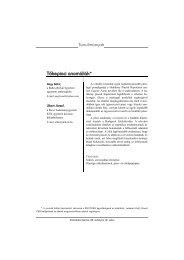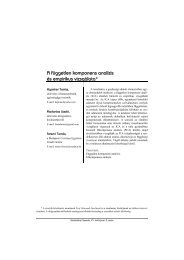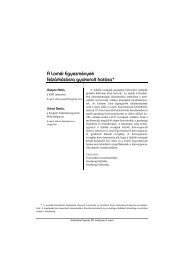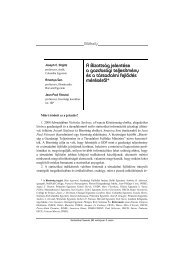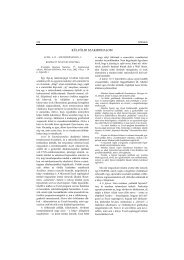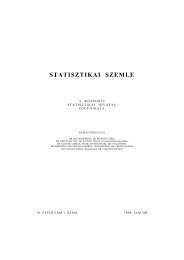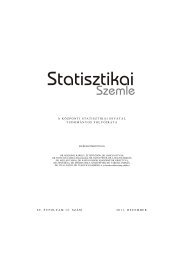A benzin és a gázolaj magyarországi árszintjének és árazásának ...
A benzin és a gázolaj magyarországi árszintjének és árazásának ...
A benzin és a gázolaj magyarországi árszintjének és árazásának ...
You also want an ePaper? Increase the reach of your titles
YUMPU automatically turns print PDFs into web optimized ePapers that Google loves.
A <strong>benzin</strong> <strong>és</strong> a <strong>gázolaj</strong> <strong>magyarországi</strong> <strong>árszintjének</strong> <strong>és</strong> <strong>árazásának</strong> empirikus elemz<strong>és</strong>e<br />
BAUMOL, W. J. – SIDAK, J. G. [1994]: The Pricing of Inputs Sold to Competitors. Yale Journal on<br />
Regulation. 11. évf. 1. sz. 171–202. old.<br />
BRADLEY, I. – PRICE, C. [1988]: The Economic Regulation of Private Industries by Price<br />
Constraints. Journal of Industrial Economics. 37. évf. 1. sz. 99–106. old.<br />
BRENNAN, T. J. [1989]: Regulating by Capping Prices. Journal of Regulatory Economics. 1. évf. 2.<br />
sz. 133–147. old.<br />
BUCHANAN, J. M. [1992]: Piac, állam, alkotmányosság. Közgazdasági <strong>és</strong> Jogi Könyvkiadó. Budapest.<br />
CULLIS, J. – PHILIP, J. [2003]: Közpénzügyek <strong>és</strong> közösségi dönt<strong>és</strong>ek. Aula Kiadó. Budapest.<br />
DEMSETZ, H. [1968]: Why Regulate Utilities? Journal of Law and Economics. 11. évf. 1. sz. 55–65.<br />
old.<br />
GV (GAZDASÁGI VERSENYHIVATAL) [2010]: A GVH 20 éve – az Országgyűl<strong>és</strong>i beszámolók tükrében.<br />
http://www.gvh.hu/domain2/files/modules/module25/146616C7C2A47F248.pdf<br />
HAMILTON, J. D. [1994]: Time Series Analysis. Princeton Univerity Press. Princeton, New Yersey.<br />
HUNYADI L. – MUNDRUCZÓ GY. –VITA L. [1996]: Statisztika. Aula Kiadó. Budapest.<br />
KSH (KÖZPONTI STATISZTIKAI HIVATAL) [2008]: ÁKM, Forrás- <strong>és</strong> felhasználástáblák. www.ksh.hu<br />
(Tájékoztatási adatbázis/Nemzeti számlák.)<br />
MADDALA, G. S. [2004]: Bevezet<strong>és</strong> az ökonometriába. Nemzeti Tankönyvkiadó. Budapest.<br />
MÁK F. [2011]: Egységgyöktesztek alkalmazása strukturális tör<strong>és</strong>ek mellett a hazai <strong>benzin</strong>ár példáján.<br />
Statisztikai Szemle. 89. évf. 5. sz. 545–573. old.<br />
REICH, R. B. [2009]: Szuperkapitalizmus. Gondolat kiadó. Budapest.<br />
SAMUELSON, P. A. – NORDHAUS, W. D. [2000]: Közgazdaságtan. Közgazdasági <strong>és</strong> Jogi Könyvkiadó.<br />
Budapest.<br />
STIEGLER , G. J. [1989]: Piac <strong>és</strong> állami szabályozás. Közgazdasági <strong>és</strong> Jogi Könyvkiadó. Budapest.<br />
TWADA, M. – KATAYAMA, S.-I. [1990]: On the Technical Efficiency under Regulation: A Case for the<br />
Japanese Electric Power Industry. The Economic Studies Quarterly. 41. évf. 1. sz. 34–47. old.<br />
VICKERS, J. [1997]: Regulation, Competition, and the Structure of Prices. Oxford Review of<br />
Economic Policy. 13. évf. 1. sz. 15–26. old.<br />
VOGELSANG, I. – FINSINGER, J. [1979]: A Regulatory Adjustment Process for Optimal Pricing by<br />
Multiproduct Monopoly Firms. The Bell Journal of Economics. 10. évf. 1. sz. 157–171. old.<br />
Summary<br />
This paper explores changes in the price of gasoline in Hungary between 2000 and 2010. In the<br />
first section the author examines whether gasoline prices increased disproportionately compared to the<br />
general inflation. (The answer is a resounding no.) In relation to this, he describes methods to assess<br />
the magnitude of the reverberating impact of gasoline prices – a well-known phenomenon also observed<br />
in Hungary. In this first part he further explores the question whether gasoline is expensive in<br />
Hungary compared to other EU countries. (The answer, again, is no, the price depends primarily on<br />
the level of taxation and this is not higher in Hungary than in the EU). In the second part of the paper<br />
the author examines indirect price regulation mechanisms. He analyses how large producers adjust<br />
prices according to changes in the stock market and how profit is made in this process. In addition, he<br />
develops alternative price regulatory mechanisms, which may lead to less volatility.<br />
Statisztikai Szemle, 89. évfolyam 6. szám<br />
643



